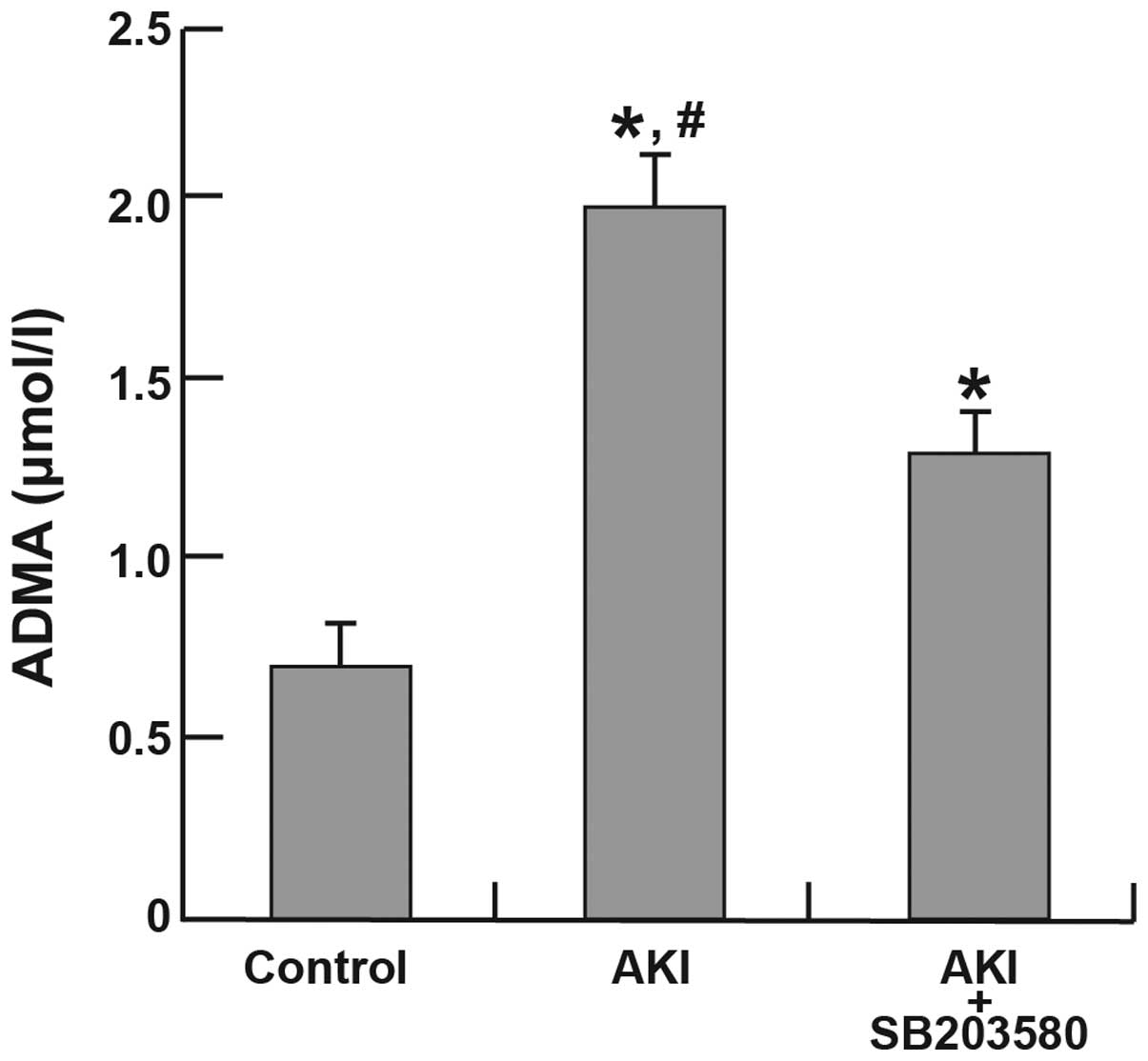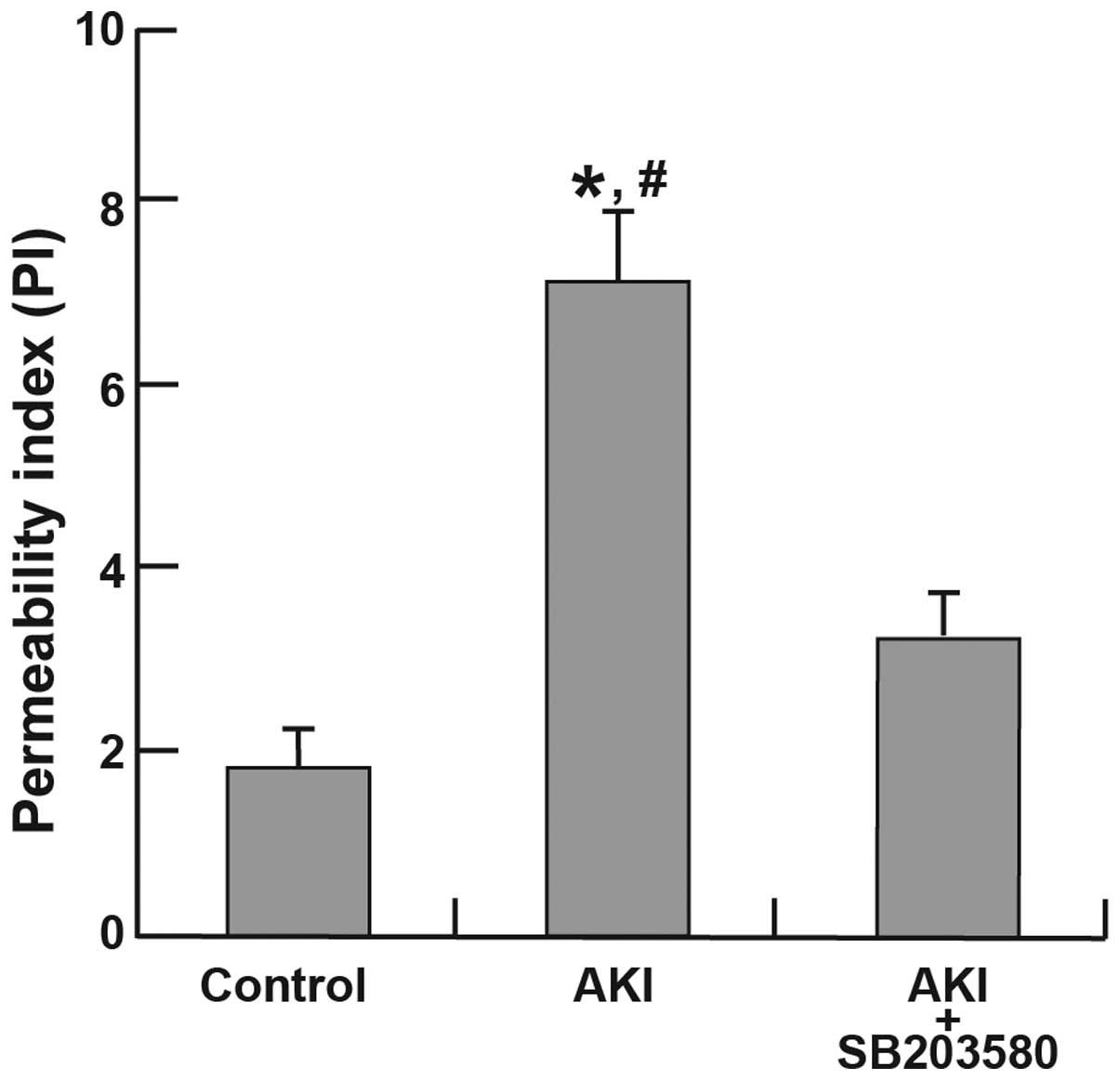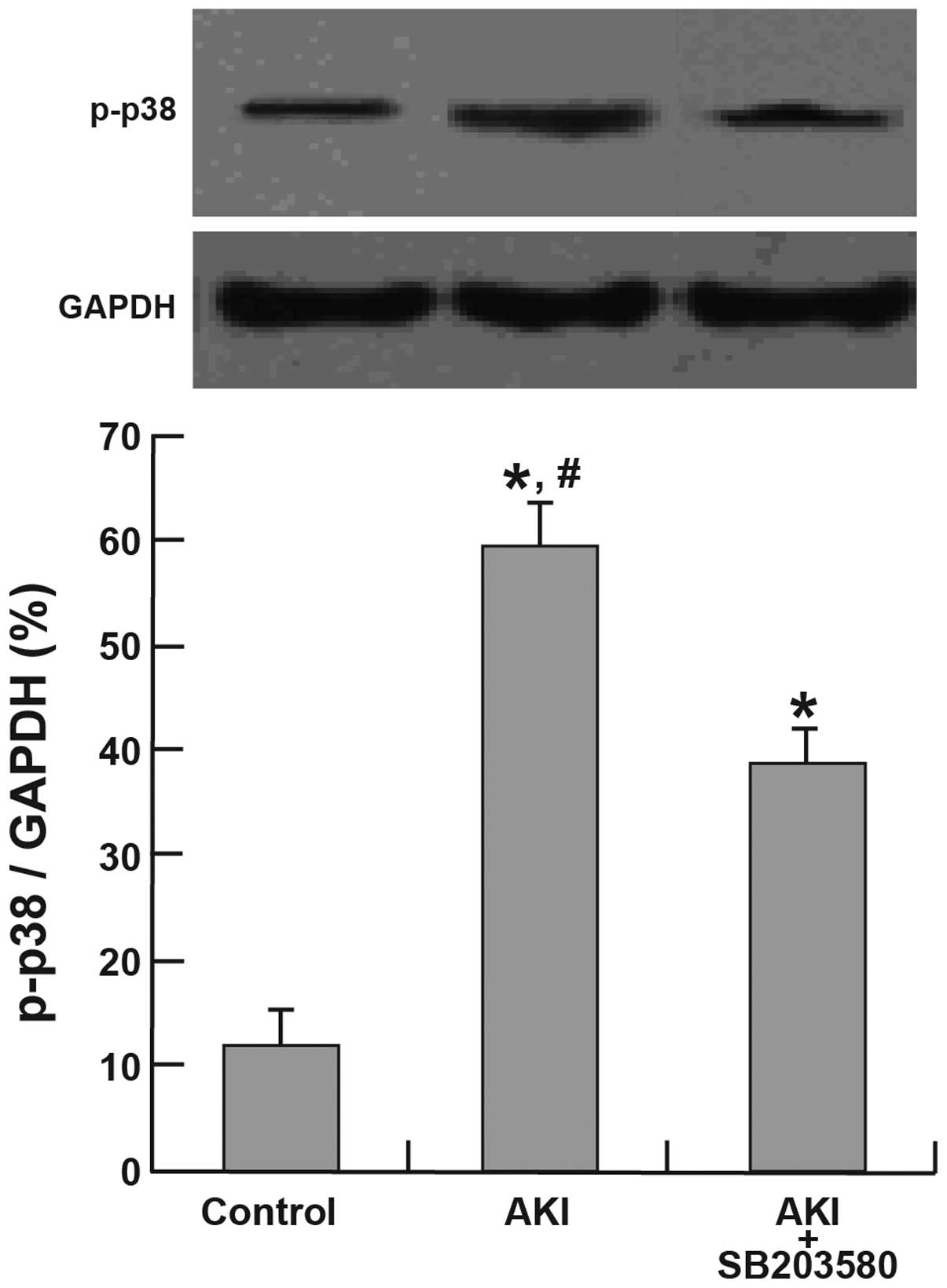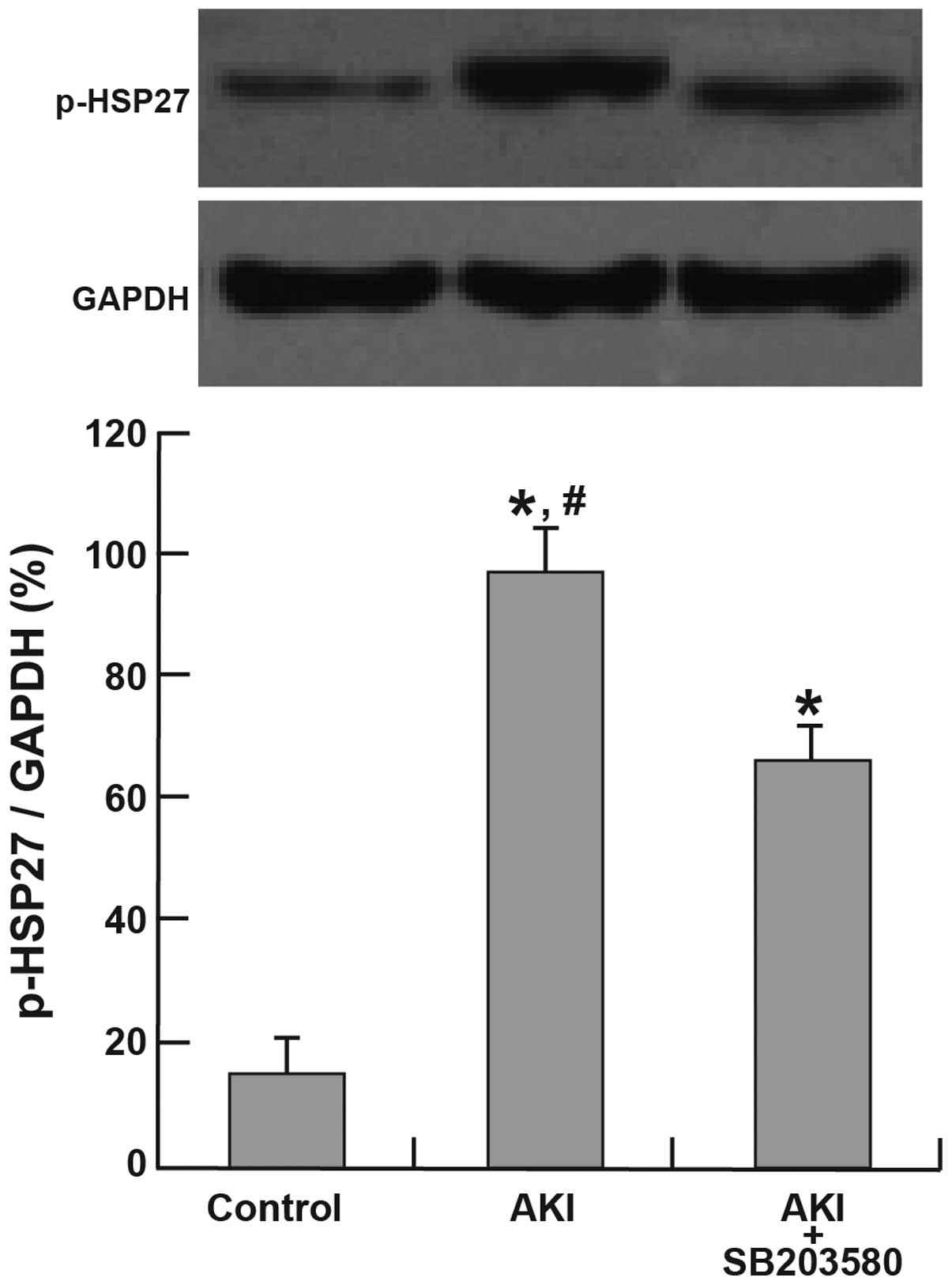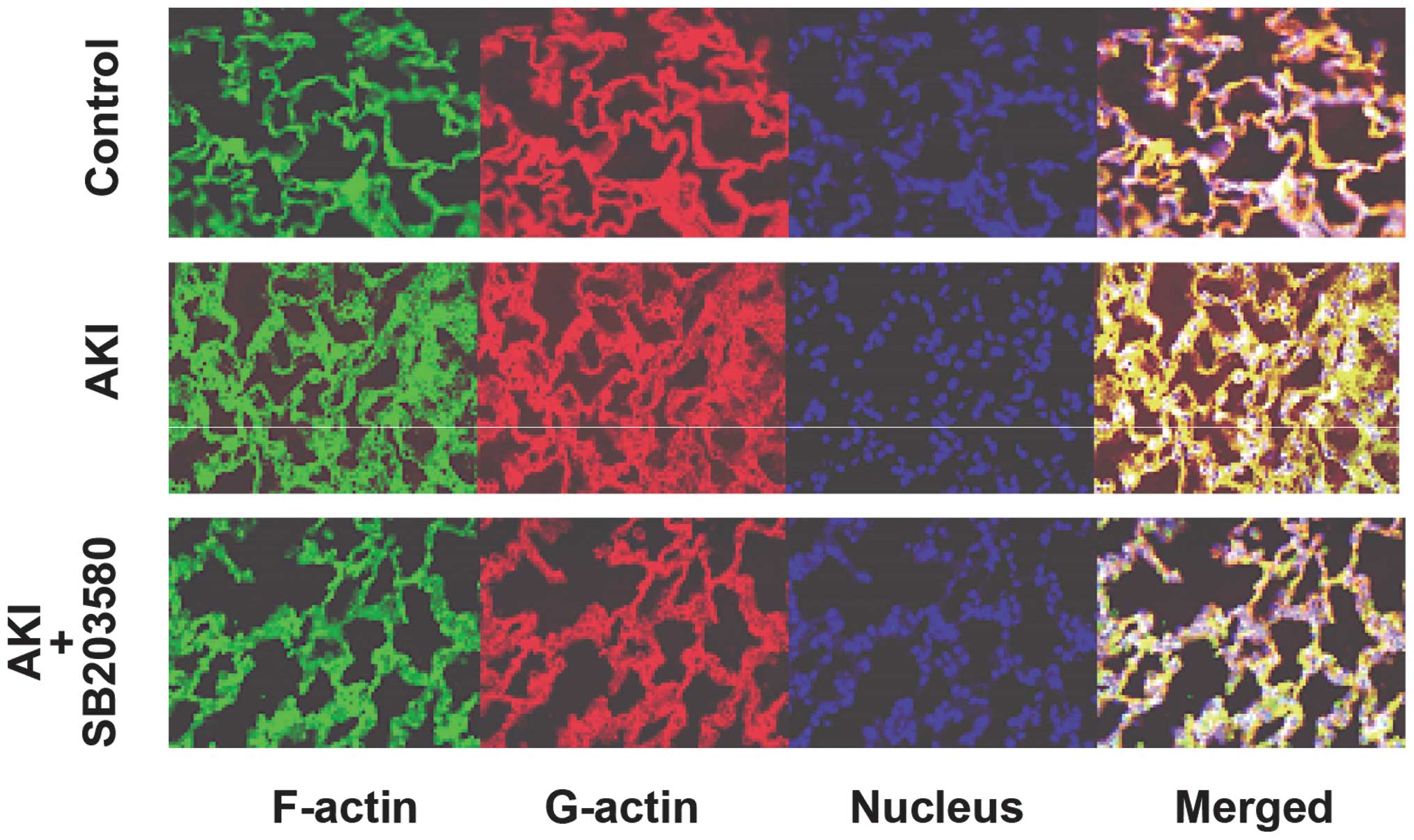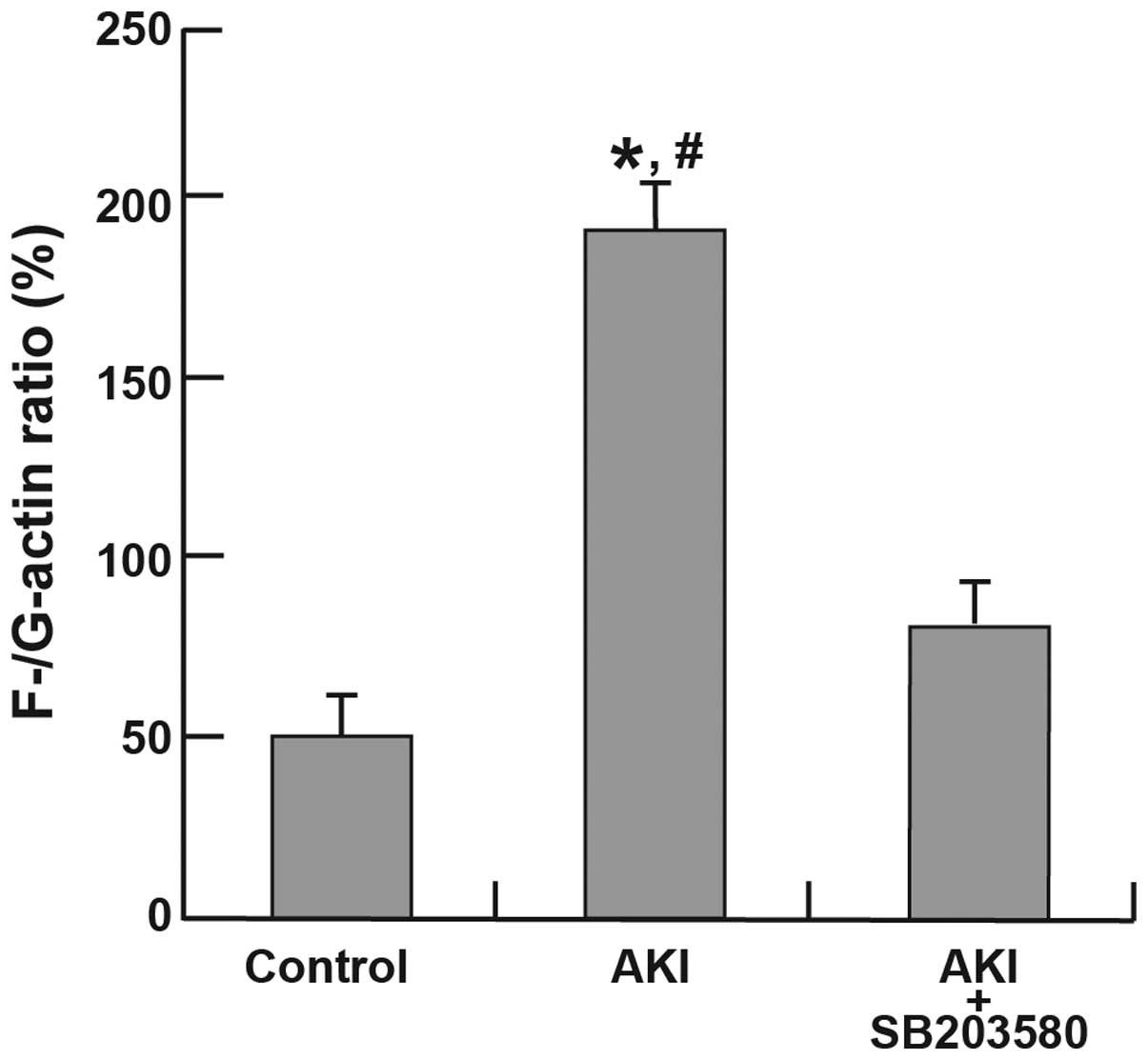Role of asymmetric dimethylarginine in rat acute lung injury induced by acute ischemic kidney injury
- Authors:
- Published online on: April 15, 2015 https://doi.org/10.3892/mmr.2015.3619
- Pages: 1923-1928
Abstract
Introduction
Acute kidney injury (AKI) is a relatively common complication in hospitalized patients with an overall mortality rate of ~30% (1,2). AKI is associated with a high mortality rate and may lead to increased hospital costs (3). Previous studies have demonstrated that 5–10% of patients admitted to the intensive care unit (ICU) developed AKI and required renal replacement therapy (RRT) (4,5). Although the mortality rate of AKI has been reduced since the application of RRT, its mortality rate remains as high as 40–70% (6). Among all the internal organs, the lung is most easily damaged by ischemic injuries due to the extensive vascular network in the lung mesenchyme (7). It is well established that cardiac and non-cardiac acute lung injuries (ALI) are the main causes of mortality in patients with AKI (8). Although the exact pathophysiology of AKI-induced ALI remains to be elucidated, the general mechanisms underlying AKI-induced ALI are well understood, including inflammation, activation of soluble and cellular factors as well as neurohumoral and hemodynamic alterations (9).
Asymmetric dimethylarginine (ADMA) is an endogenous nitric oxide (NO) synthase inhibitor, which may affect the biological activity of NO (10). ADMA is a naturally occurring amino acid that is found in tissues and cells, circulates in the plasma and is expelled in the urine (11). ADMA is eliminated through metabolic degradation and renal excretion (12). Increased blood concentrations of ADMA may contribute to endothelial dysfunction, thereby linking to the development and progression of chronic and acute kidney diseases (13). Activation of the p38 mitogen-activated protein kinase (MAPK)/heat shock protein 27 (HSP27) pathway by elevated ADMA has been verified, and is involved in endothelial dysfunction and abnormal permeability (10,14). Thus, the excessive accumulation of ADMA accompanied by elevated HSP27 levels provides a potential explanation for the occurrence of AKI-induced ALI. The aim of the present study was to establish a rat model of acute ischemic kidney injury by continually occluding the bilateral renal artery and renal veins. In addition, the roles of ADMA in the development of AKI-induced ALI were examined.
Materials and methods
Study approval
The animal use protocol was reviewed and approved by the Institutional Animal Care and Use Committee of the First Affiliated Hospital of China Medical University (Shenyang, Liaoning, China). The present study was performed strictly in accordance with the recommendations of the Guide for the Care and Use of Laboratory Animals of the National Institutes of Health (Bethesda, MA, USA).
Animal models
In total, 45 male Wistar rats, weighing 300–320 g, were provided by the Experimental Animal Center of the China Medical University. A solution of 5% chloral hydrate (300 mg/kg) was used to anesthetize the rats followed by tracheotomy. The arteria cervicalis and jugular vein of the rats were punctured and a catheter was embedded. Respiratory frequency, heart rate, systolic pressure, diastolic pressure, mean arterial blood pressure and central venous pressure were monitored. The rats were allocated at random into three groups (n=15) 30 min after attaining a stable state (Table I).
Specimen collection and preservation
Following establishment of the models, all the rats were sacrificed 24 h after initiation of the experiment. For each rat, the venous blood sample was collected to detect ADMA levels. Then, the chest was opened to expose the lungs. Following ligation of the right hilum, the upper-right lung was harvested and fixed with 4% paraformaldehyde. Hematoxylin and eosin (H&E) staining of plastic-embedded tissue sections was examined by light microscopy (Motic BA 400; Motic, Xiamen, China).
Detection of plasma ADMA levels by enzyme linked immunosorbent assay (ELISA)
The double sandwich ELISA method was used to measure plasma ADMA levels and was conducted according to the manufacturer’s instructions (Shanghai Senxiong Biotech Industry Co., Ltd., Shanghai, China).
Detection of p38 MAPK/HSP27 by western blot analysis
Protein was extracted from the right lung lobe and preserved at −80°C following detection of the protein concentration. The protein sample (100 µg) was electrophoresed in 12% sodium dodecyl sulfate polyacrylamide gel electrophoresis (JY-JX5L; Beijing Jun Yi Huaxin Technology Co., Ltd., Beijing, China) and then transferred onto polyvinylidene fluoride membranes (Kynar K760; Inc., Philadelphia, PA, USA) using a constant voltage (120 V) at 4°C. The membranes were sealed with 5% skimmed milk powder at room temperature (22°C) for 1 h.
The polyclonal p38MAPK (threonine 180 and tyrosine 182; 1:1,000; cat. no. AM065) and polyclonal p-HSP27 primary antibodies (1:1,000 dilution; cat. no. AH728) and GAPDH (an internal standard) primary antibody (1:500 dilution; cat. no. AG019). All antibodies were purchased from Beyotime Institute of Biotechnology (Shanghai, China) were mixed with the solution. Following overnight incubation at 4°C, horseradish peroxidase-labeled rabbit anti-mouse secondary antibody (Sigma-Aldrich, St. Louis, MO, USA) at a dilution of 1:1,000 was added into the mixture, which caused a color change following incubation at room temperature for 1 h. Images were captured using photographic photometry on an Exilim EX-FC100 digital camera (Casio, Shibuya, Japan) and the experimental results were analyzed using Quantity One Software (Bio-Rad Laboratories, Hercules, CA, USA). The optical density value was scanned and presented as the ratio of protein-to-internal standard GAPDH.
Immunofluorescent detection of globular actin (G-actin) and filamentous actin (F-actin)
Following incubation for 2 h, dewaxing in xylene (Sigma-Aldrich) and rehydrating in ethanol (Sigma-Aldrich), the sections were rinsed three times (5 min each time) with 30 ml phosphate-buffered saline (PBS; pH 7.4; Gibco-BRL, Carslbad, CA, USA) with 1 mg/ml glucose at 25°C. Microwave antigen retrieval was conducted subsequently using a microwave oven, microwave with pressure cooker and 0.01 M sodium citrate buffer (pH 6.0), followed by incubation for 1 h with blocking solution (buffer 1 containing 0.3% Triton X-100/2% goat serum; Sigma-Aldrich) after rinsing three times with PBS. G-actin was stained with deoxyribonuclease I (DNase I; 0.3 µM DNase I; Sigma-Aldrich). For F-actin staining, coverslips were incubated in a 10 U/ml solution (0.165 M) of fluorescein isothiocyanate-labeled phalloidin (Sigma, St. Louis, MO, USA). After rinsing with PBS, tissues were bathed in 200 µl 4′, 6-diamidino-2-phenylindole (DAPI; Roche Diagnostics, Mannheim, Germany) for at least 5 min. Green and red fluorescence protein indicated G-actin and F-actin, respectively. The nucleus showed blue fluorescence. The samples were investigated and images were captured using a fluorescence microscope (Motic BA 400T). The images were processed using digital analysis software Motic Fluo 1.0.
Statistical analysis
Continuous variables were expressed as the mean ± standard deviation. Categorical data were presented as the frequencies and percentages. Differences among the groups were compared using the two-tailed, non-paired Student’s t-test or one-way analysis of variance for continuous variables, where appropriate. Comparisons of categorical variables among groups were performed using the χ2 test. All tests of statistical significance were two-sided, with P<0.05 being considered to indicate a statistically significant difference. Statistical analyses were performed using SPSS version 17.0 (SPSS, Inc., Chicago, IL, USA).
Results
Plasma ADMA levels and pulmonary permeability index (PI)
Compared with the control group (0.69±0.13 µmol/l), the AKI (1.93±0.17 µmol/l) and AKI + SB203580 (1.33±0.09 µmol/l) groups demonstrated significant increases in plasma ADMA levels (all P<0.05). There was also a significant difference in plasma ADMA levels between the AKI and AKI + SB203580 groups (P<0.05; Fig. 1). The increase in the PI in the AKI group (6.54±0.42) was significantly higher than that in the control group (1.91±0.16; P<0.001). Significant differences in permeability were also found between the AKI group (6.54±0.42) and the AKI + SB203580 group (3.24±0.1; P=0.027). However, no significant difference in PI was identified between the control group and the AKI + SB203580 group (P=0.130; Fig. 2).
Activation of p38 MAPK and HSP27
The expression of p-p38 and p-HSP27 was significantly higher in the AKI and AKI + SB203580 groups compared with the control group (all P<0.05). The AKI group also demonstrated a higher expression of p-p38 and p-HSP27 than the AKI + SB203580 group (all P<0.05; Figs. 3 and 4).
Pathological changes of rat lung tissue
In the control group, rats exhibited good alveolar structural integrity without clear intra-alveolar exudation and interstitial pulmonary edema (Fig. 5A). By contrast, rats in the AKI group showed epithelial swelling, marked widening of alveolar walls due to capillary proliferation and congestion, which led to clear interstitial pulmonary edema with exudations of inflammatory cells, red blood cells and associated proteins, and conversely causing inflammatory cell infiltration (Fig. 5B). Small airway injury and alveolar structural disorder were also dientified in the AKI group. All the described symptoms demonstrate the pathological changes of acute lung injury (ALI). In the AKI + SB203580 group, rats also had exudations of inflammatory cells, red blood cells and associated proteins. However, compared with the AKI group, these rats demonstrated mitigations of edema (Fig. 5C).
Alterations in the F-/G-actin ratio
Immunofluorescence analyses of F-actin and G-actin are shown in Fig. 6. The expression of F-actin in the AKI group was clearer than that in the control and AKI + SB203580 groups. The F-/G-actin ratio in the AKI group was also higher compared with that of the control and AKI + SB203580 groups (all P<0.05; Fig. 7).
Discussion
AKI is a multifactorial syndrome and may be accompanied by multiple organ injury, including ALI or acute respiratory distress syndrome, particularly in critically ill patients (15,16). Patients with AKI who are treated with RRT have a high mortality rate of 50–60% (17). It is well established that AKI is associated with a high mortality rate and distant organ dysfunctions. The current theory is that AKI induces pathological alterations of the lung, which predispose patients to a poor prognosis (2). The lung is the most easily damaged by ischemic injury due to the extensive vascular network in the lung mesenchyme (7). Findings of previous studies have indicated that ICU patients with AKI-induced ALI have a mortality rate of ~80% (18). In a previous study, it was found that ALI usually occurs during the early stages of AKI, characterized by inflammatory cell infiltration, hyperemia in alveolar space and alterations in the structure of pulmonary alveoli (19). Microscopically, evidence of pulmonary endothelial injury was observed, including endothelial cell swelling, widening of interendothelial junctions and an increased number of pinocytotic vesicles.
Impaired epithelial barrier integrity and function are important features of ALI (20). It has been demonstrated that endothelial cell structure is maintained by the cyto-skeleton, which is possibly responsible for maintaining and restoring normal cell morphology and functions (21). The actin microfilaments, which are mainly composed of F-actin and actin-binding proteins, are a major component of the cytoskeleton and are intricately involved mechanically and biochemically in various cell processes, including cell division and motility (22). It is well established that the polymerization-depolymerization dynamics of actin is a crucial process in a wide variety of cellular functions (23). HSP27, the F-actin polymerization modulator, is important in the reorganization of the actin cytoskeleton network of cells (24). It has been demonstrated that non-phosphorylated HSP27 was able to promote the reduction of F-actin in cells, thereby inhibiting F-actin polymerization (25). Activation of p38 caused the activation of MAPK-activated protein kinase-2/3 and phosphorylation of HSP27, leading to the F-actin polymerization and extension, and thereby inducing the recombination of the actin cytoskeleton and increase in intracellular space (26). These alterations may ultimately lead to the impairment of the barrier function of pulmonary endothelium and cause AKI.
In the present study, it was found that increased p-HSP27 may be associated with increases in the F/G-actin ratio and the degree of lung injury. It has been demonstrated that p-HSP27 was not able to inhibit F-actin polymerization and extension, which may promote the impairment of the integrity and dysfunction of the pulmonary endothelial and epithelial barrier (27). The present study also found that the expression levels of p-HSP27 demonstrated an expected positive correlation with p-p38 MAPK. The SB203580, an inhibitor of the p38 MAPK pathway, may decrease the expression levels of p-HSP27, indicating that p38 MAPK regulates the expression of p-HSP27.
The present study has demonstrated that ischemia-induced AKI rats exhibited significantly higher plasma ADMA levels than those in the control group. H&E staining showed the typical pathological alterations of ALI, including alveolar inflammation, impairment of alveolar integrity and cell infiltration. Furthermore, p-p38MAPK, p-HSP27 and F-actin also progressively increased. Nevertheless, SB203580 was able to inhibit the expression of p-HSP27 and F-actin followed by reciprocal alleviation of ALI. A possible explanation may be that the activation of p38 MAPK downregulated the activity of HSP27, thereby inducing pulmonary vascular endothelial cell regeneration and reorganization. These alterations may affect cell permeability. The results suggested that the p38 MAPK/HSP27 signaling pathway is important in the development of AKI-induced ALI.
In conclusion, the results from the present study indicate that the plasma levels of ADMA may be a good biomarker for AKI-induced ALI. Furthermore, the p38 MAPK/HSP27 pathway is important in modulating the levels of ADMA.
Acknowledgments
The present study was supported by the Fund for Scientific Research of The First Hospital Of China Medical University (fsfh1103) and the Science and Technology project of Shenyang (F11-264-1-52).
References
|
Liu KD, Himmelfarb J, Paganini E, et al: Timing of initiation of dialysis in critically ill patients with acute kidney injury. Clin J Am Soc Nephrol. 1:915–919. 2006. View Article : Google Scholar | |
|
Himmelfarb J and Ikizler TA: Acute kidney injury: changing lexicography, definitions, and epidemiology. Kidney Int. 71:971–976. 2007. View Article : Google Scholar : PubMed/NCBI | |
|
Akcan-Arikan A, Zappitelli M, Loftis LL, et al: Modified RIFLE criteria in critically ill children with acute kidney injury. Kidney Int. 71:1028–1035. 2007. View Article : Google Scholar : PubMed/NCBI | |
|
Mehta RL, Kellum JA, Shah SV, et al: Acute Kidney Injury Network: report of an initiative to improve outcomes in acute kidney injury. Crit Care. 11:R312007. View Article : Google Scholar : PubMed/NCBI | |
|
Schwenger V, Weigand MA, Hoffmann O, et al: Sustained low efficiency dialysis using a single-pass batch system in acute kidney injury – a randomized interventional trial: the REnal Replacement Therapy Study in Intensive Care Unit PatiEnts. Crit Care. 16:R1402012. View Article : Google Scholar | |
|
Martin A and Acierno MJ: Continuous renal replacement therapy in the treatment of acute kidney injury and electrolyte disturbances associated with acute tumor lysis syndrome. J Vet Intern Med. 24:986–989. 2010. View Article : Google Scholar : PubMed/NCBI | |
|
Kuchnicka K and Maciejewski D: Ventilator-associated lung injury. Anaesthesiol Intensive Ther. 45:164–170. 2013. View Article : Google Scholar : PubMed/NCBI | |
|
Hassoun HT, Grigoryev DN, Lie ML, et al: Ischemic acute kidney injury induces a distant organ functional and genomic response distinguishable from bilateral nephrectomy. Am J Physiol Renal Physiol. 293:F30–F40. 2007. View Article : Google Scholar : PubMed/NCBI | |
|
White LE, Chaudhary R, Moore LJ, et al: Surgical sepsis and organ crosstalk: the role of the kidney. J Surg Res. 167:306–315. 2011. View Article : Google Scholar : PubMed/NCBI | |
|
Böger RH: Asymmetric dimethylarginine, an endogenous inhibitor of nitric oxide synthase, explains the ‘L-arginine paradox’ and acts as a novel cardiovascular risk factor. J Nutr. 134:2842S–2847S. 2004. | |
|
Vallance P and Leiper J: Cardiovascular biology of the asymmetric dimethylarginine:dimethylarginine dimethyl-aminohydrolase pathway. Arterioscler Thromb Vasc Biol. 24:1023–1030. 2004. View Article : Google Scholar : PubMed/NCBI | |
|
Palm F, Onozato ML, Luo Z, et al: Dimethylarginine dimethyl-aminohydrolase (DDAH): expression, regulation, and function in the cardiovascular and renal systems. Am J Physiol Heart Circ Physiol. 293:H3227–H3245. 2007. View Article : Google Scholar : PubMed/NCBI | |
|
Fliser D, Kronenberg F, Kielstein JT, et al: Asymmetric dimethyl arginine and progression of chronic kidney disease: the mild to moderate kidney disease study. J Am Soc Nephrol. 16:2456–2461. 2005. View Article : Google Scholar : PubMed/NCBI | |
|
Wang LY, Zhang DL, Zheng JF, et al: Apelin-13 passes through the ADMA-damaged endothelial barrier and acts on vascular smooth muscle cells. Peptides. 32:2436–2443. 2011. View Article : Google Scholar : PubMed/NCBI | |
|
Chertow GM, Burdick E, Honour M, et al: Acute kidney injury, mortality, length of stay, and costs in hospitalized patients. J Am Soc Nephrol. 16:3365–3370. 2005. View Article : Google Scholar : PubMed/NCBI | |
|
Togel F, Weiss K, Yang Y, et al: Vasculotropic, paracrine actions of infused mesenchymal stem cells are important to the recovery from acute kidney injury. Am J Physiol Renal Physiol. 292:F1626–F1635. 2007. View Article : Google Scholar : PubMed/NCBI | |
|
Hoste EA and Schurgers M: Epidemiology of acute kidney injury: how big is the problem? Crit Care Med. 36:S146–S151. 2008. View Article : Google Scholar : PubMed/NCBI | |
|
Coca SG, Yusuf B, Shlipak MG, et al: Long-term risk of mortality and other adverse outcomes after acute kidney injury: a systematic review and meta-analysis. Am J Kidney Dis. 53:961–973. 2009. View Article : Google Scholar : PubMed/NCBI | |
|
Ma T and Liu Z: Functions of aquaporin 1 and alpha-epithelial Na+ channel in rat acute lung injury induced by acute ischemic kidney injury. Int Urol Nephrol. 45:1187–1196. 2013. View Article : Google Scholar | |
|
Vadasz I, Raviv S and Sznajder JI: Alveolar epithelium and Na,K-ATPase in acute lung injury. Intensive Care Med. 33:1243–1251. 2007. View Article : Google Scholar : PubMed/NCBI | |
|
Banan A, Choudhary S, Zhang Y, et al: Oxidant-induced intestinal barrier disruption and its prevention by growth factors in a human colonic cell line: role of the microtubule cytoskeleton. Free Radic Biol Med. 28:727–738. 2000. View Article : Google Scholar : PubMed/NCBI | |
|
Rosenthal KS, Perez R and Hodnichak C: Inhibition of herpes simplex virus type 1 penetration by cytochalasins B and D. J Gen Virol. 66:1601–1605. 1985. View Article : Google Scholar : PubMed/NCBI | |
|
Fujiwara I, Takahashi S, Tadakuma H, et al: Microscopic analysis of polymerization dynamics with individual actin filaments. Nat Cell Biol. 4:666–673. 2002. View Article : Google Scholar : PubMed/NCBI | |
|
Weber NC, Toma O, Wolter JI, et al: Mechanisms of xenon- and isoflurane-induced preconditioning – a potential link to the cytoskeleton via the MAPKAPK-2/HSP27 pathway. Br J Pharmacol. 146:445–455. 2005. View Article : Google Scholar : PubMed/NCBI | |
|
Loktionova SA and Kabakov AE: Protein phosphatase inhibitors and heat preconditioning prevent Hsp27 dephosphor-ylation, F-actin disruption and deterioration of morphology in ATP-depleted endothelial cells. FEBS Lett. 433:294–300. 1998. View Article : Google Scholar : PubMed/NCBI | |
|
Rousseau S, Houle F, Landry J, et al: p38 MAP kinase activation by vascular endothelial growth factor mediates actin reorganization and cell migration in human endothelial cells. Oncogene. 15:2169–2177. 1997. View Article : Google Scholar : PubMed/NCBI | |
|
Xiong Z, Wang Y, Gong W, et al: Expression of Hsp27 correlated with rat detrusor contraction after acute urinary retention. Mol Cell Biochem. 381:257–265. 2013. View Article : Google Scholar : PubMed/NCBI |



